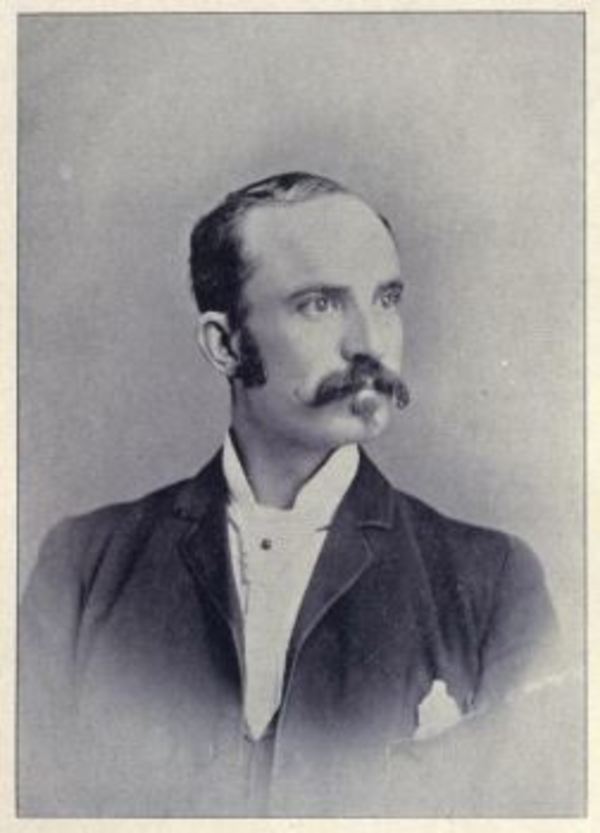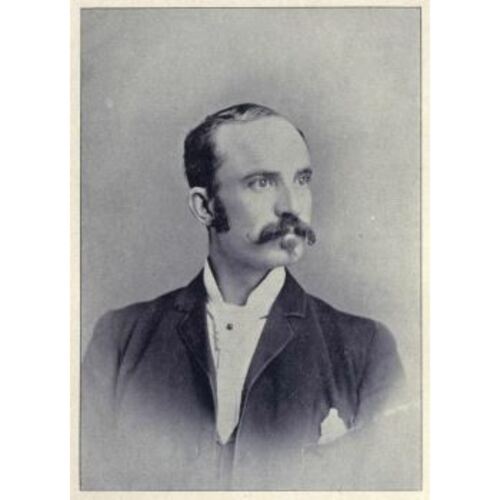As part of the funding agreement between the Dictionary of Canadian Biography and the Canadian Museum of History, we invite readers to take part in a short survey.

Source: Link
BURROWS, THEODORE ARTHUR, sawmill owner, railway land commissioner, lumber merchant, politician, and lieutenant governor; b. 15 Aug. 1857 in Ottawa, son of Henry John Burrows and Sarah Sparks; grandson of John Burrows*; m. 25 Oct. 1899 Georgina Kathleen Creasor in Owen Sound, Ont., and they had a son and a daughter; d. 18 Jan. 1929 in Winnipeg.
Orphaned at an early age, Theodore Arthur Burrows attended public schools in Ottawa and arrived in Winnipeg in 1875. He worked briefly for his uncle William Ogilvie at the Dominion Lands Survey. A restless young man, Burrows tried and abandoned both legal studies and a career in real estate before he found his niche. In 1878 he formed a partnership to purchase a small sawmill at Fort Alexander. In 1883 he dissolved this partnership and established the Selkirk Lumber Company. Lumber was in great demand at the time. Within three years the firm became one of the largest in the province, producing 4,000,000 board feet per year.
Business and politics were often the foundation of lucrative careers in 19th-century Canada. In 1890, during a slump in the lumber industry, Burrows built a colonization road into the Dauphin area. He thought that connections to prominent politicians would help him to develop the lumber resources of this newly opened settlement frontier, so in 1892 he stood in Dauphin for election to the Legislative Assembly as a Liberal Conservative (the label was consciously ambiguous). He successfully promoted a railway link to his constituency. Burrows was appointed land commissioner for the Lake Manitoba Railway by its contractors, William Mackenzie and Donald Mann*, in 1896. The position gave him access to information about future routes and allowed him to acquire valuable timber berths along the railway pushing up into northwestern Manitoba. Moreover, Burrows’s sister Elizabeth Armanella (Arma) had married Liberal politician Clifford Sifton in 1884. When Sifton became federal minister of the interior in 1896, and thus responsible for the disposition of western resources, Burrows’s prospects continued to improve.
Burrows’s success in acquiring timber berths was quite evident during the period when Sifton had discretionary authority to allot them and, in addition, was willing to influence the tendering system. Sifton’s actions brought howls from the Conservative opposition who hounded him on the subject in the House of Commons from 1899 to 1906 – to little avail as it turned out. Until Sifton resigned his portfolio in 1905, Burrows used their relationship to advance his business interests. By 1908 Burrows held more timberlands in western Canada than any other person.
Burrows’s prominence as a businessman had launched his political career and in the end it was also his undoing. Although he was a major employer in the Dauphin district, his hold on his seat in the assembly was chancy. He had won by only nine votes in 1892 and when he sought re-election in January 1896 he increased his margin by just three votes; he defeated Archibald Glenlyon Campbell* on both occasions. He continued to identify himself as a Liberal Conservative, but supported Liberal premier Thomas Greenway*. Not an active member, he depended a good deal on his railway connections and on Sifton’s access to local patronage. Although only issues of economic development affecting his own district (and thus himself) drew his interest, his performance was enough to win him another term in 1899; during this term he sat as a Liberal. He declined to stand in 1903. But he was not finished with politics.
The following year, as one of Sifton’s Manitoba lieutenants, Burrows was well placed to win the nomination in the new federal constituency of Dauphin. Election notices were delayed, however, and the vote postponed until after the national election on 3 November. When it was evident that Sir Wilfrid Laurier*’s Liberal party had won a comfortable majority, Burrows’s Conservative opponent withdrew, allowing him to win by acclamation. In the House of Commons, Burrows devoted himself to western development, especially to the Hudson Bay Railway and the extension of Manitoba’s boundaries. He was continually badgered by the opposition over his timber business. From 1906 to 1908 the Conservatives under Robert Laird Borden* waged a campaign to discredit the government on charges of corruption and Burrows was an inviting target. They failed to overturn Laurier in the general election of 1908 but the attacks proved politically fatal to Burrows. He was beaten rather badly.
Burrows then confined himself to the consolidation and expansion of his lumber business. In Manitoba he had two major sawmills, in Grandview and Bowsman, and other lesser operations under various company names, making him the largest producer of lumber in the province. In north-central Alberta he and Sir Daniel Hunter McMillan* were the principal shareholders of the small Imperial Pulp Company. In 1911 he formed the larger Phoenix Lumber Company to carry on operations there. The following year he began to expand his retail operations. His prosperous Northern Lumber Company eventually had some 30 retail outlets across the prairies. Burrows had been a founding member of the Western Retail Lumbermen’s Association, established in 1890 to serve its members by limiting entry to the business and holding the line on prices.
Although Burrows never stood for office again, he maintained a keen interest in the fortunes of the Liberal party. After World War I, he deplored the emergence of the Progressive party and only reluctantly cooperated with it to avoid three-party elections. He was gratified to see the Liberals win a majority in the election of 1926. Later that year, when Sir James Albert Manning Aikins relinquished the lieutenant governorship of Manitoba, Burrows was a candidate to succeed him both because of his Liberal credentials and his financial ability to bear the social expenditures of the office. Pressure on Prime Minister William Lyon Mackenzie King* from Sifton and John Wesley Dafoe* of the Manitoba Free Press (Winnipeg) combined to secure him the position in October. It was now largely a ceremonial office and, by all accounts, Burrows was a social success – but not for long. He died of complications from appendicitis in January 1929.
Burrows was typical of many frontier entrepreneurs. Political and social connections were at the service of personal ambition and business. He used his connections, as well as his ability, to win a prominent place in the developing prairie west.
AM, MG 12, J. Man. Culture, Heritage and Recreation, Hist. resources branch (Winnipeg), Lyle Dick, “T. A. Burrows, timber baron of the northwest” (unpublished research paper, 1976). LAC, MG 26, J; MG 27, II, D15; RG 15. QUA, Thomas Alexander Crerar fonds. Univ. of Man. Libraries, Dept. of Arch. and Special Coll. (Winnipeg), J. W. Dafoe fonds. A. F. J. Artibise, Winnipeg: a social history of urban growth, 1874–1914 (Montreal and London, 1975). R. C. Brown, “The politics of Billingsgate,” in The west and the nation; essays in honour of W. L. Morton, ed. Carl Berger and Ramsay Cook (Toronto, 1976): 161–73. J. M. S. Careless, “The development of the Winnipeg business community, 1870–1890,” RSC, Trans., 4th ser., 8 (1970): 239–54. CPG, 1892–1908. D. J. Hall, Clifford Sifton (2v., Vancouver and London, 1981–85). D. F. Parrot, “Grandview and Theodore A. Burrows,” Manitoba Hist. (Winnipeg), no.21 (spring 1991): 22–23. T. D. Regehr, The Canadian Northern Railway, pioneer road of the northern prairies, 1895–1918 (Toronto, 1976). Theodore Sparks, “The early lumber industry of Winnipeg,” in “Northwest Review,” 45th anniversary (Winnipeg, 1930). Standard dict. of Canadian biog. (Roberts and Tunnell). Deborah Welch, “T. A. Burrows, 1857–1929: case study of a Manitoba businessman and politician” (ma thesis, Univ. of Man., 1983).
Cite This Article
J. E. Rea, “BURROWS, THEODORE ARTHUR,” in Dictionary of Canadian Biography, vol. 15, University of Toronto/Université Laval, 2003–, accessed March 28, 2025, https://www.biographi.ca/en/bio/burrows_theodore_arthur_15E.html.
The citation above shows the format for footnotes and endnotes according to the Chicago manual of style (16th edition). Information to be used in other citation formats:
| Permalink: | https://www.biographi.ca/en/bio/burrows_theodore_arthur_15E.html |
| Author of Article: | J. E. Rea |
| Title of Article: | BURROWS, THEODORE ARTHUR |
| Publication Name: | Dictionary of Canadian Biography, vol. 15 |
| Publisher: | University of Toronto/Université Laval |
| Year of revision: | 2005 |
| Access Date: | March 28, 2025 |



